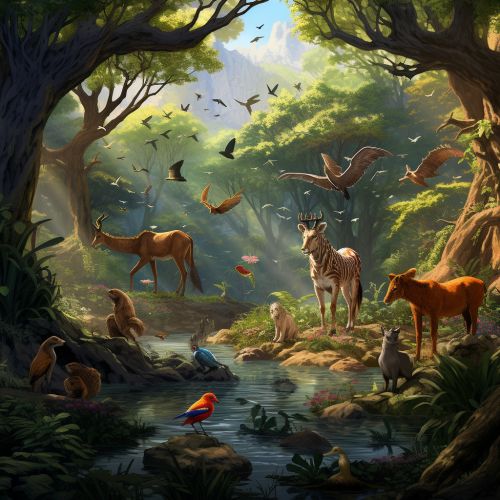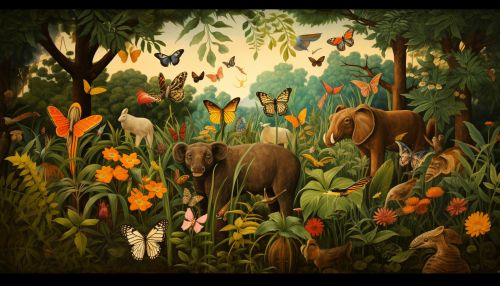Animal Nutrition
Introduction
Animal nutrition involves the dietary needs of animals, which vary significantly in both type and quantity. This field of study encompasses both the dietary needs of domestic animals and those of wild species.
Nutritional Requirements
All animals require both macronutrients and micronutrients to maintain optimal health. Macronutrients include proteins, fats, and carbohydrates, which provide energy and building blocks for growth and repair. Micronutrients, such as vitamins and minerals, are required in smaller amounts but are still essential for various physiological functions.
Proteins
Proteins are complex molecules made up of amino acids, and they play a crucial role in most biological processes. They are necessary for growth, tissue repair, immune function, and the creation of enzymes and hormones. The dietary requirement for protein varies between species, life stages, and with the quality of the protein source.
Fats
Fats are a concentrated source of energy for animals. They are also necessary for the absorption of fat-soluble vitamins (A, D, E, and K), and for the production of certain hormones. Essential fatty acids, such as omega-3 and omega-6, must be included in the diet as they cannot be synthesized by the animal's body.
Carbohydrates
Carbohydrates provide a readily available energy source. They can be classified into simple carbohydrates (sugars), complex carbohydrates (starches), and dietary fiber. While some animals, such as ruminants, can derive energy from dietary fiber through microbial fermentation, others, like cats, have a limited ability to utilize carbohydrates and rely more heavily on proteins and fats for energy.
Vitamins and Minerals
Vitamins and minerals are required in small quantities but are vital for various physiological functions. They are involved in processes such as bone formation, blood clotting, immune response, and the maintenance of normal metabolism.
Nutrition Across Different Species
Different animal species have different nutritional requirements, which are influenced by factors such as size, life stage, metabolic rate, and habitat.
Carnivores
Carnivores, such as lions and wolves, have diets high in protein and fat, with minimal carbohydrates. They have a high requirement for certain nutrients that are abundant in animal tissues, such as taurine and arachidonic acid.
Herbivores
Herbivores, like cows and rabbits, consume a diet primarily composed of plant material. They have a specialized digestive system that allows them to extract nutrients from plants, including dietary fiber. Herbivores require a balance of carbohydrates, proteins, and fats in their diet, but the proportions vary depending on the species.
Omnivores
Omnivores, such as pigs and humans, can digest and utilize a wide range of plant and animal foods. They require a balanced diet of proteins, fats, and carbohydrates, along with a variety of vitamins and minerals.
Feeding Strategies
Animals employ various feeding strategies to meet their nutritional needs, which are largely influenced by their environment and the availability of food resources.
Grazing and Browsing
Grazing and browsing are common feeding strategies employed by herbivores. Grazers, like cows and sheep, primarily consume grasses, while browsers, such as deer and goats, prefer woody plants and shrubs.
Predation and Scavenging
Predation and scavenging are feeding strategies used by carnivores and some omnivores. Predators hunt and kill their prey, while scavengers consume animals that have died from other causes.
Foraging
Foraging is a feeding strategy used by many animals, including omnivores and some herbivores and carnivores. Foragers search for food in a variety of places, consuming a wide range of food items.
Nutritional Disorders
Nutritional disorders in animals can arise from both deficiencies and excesses of nutrients. These disorders can have serious health consequences and may lead to reduced growth, reproductive problems, and increased susceptibility to disease.
Deficiency Diseases
Deficiency diseases occur when an animal's diet lacks a necessary nutrient. For example, rickets, a disease caused by a deficiency in vitamin D, calcium, or phosphate, can lead to skeletal deformities in young animals.
Overnutrition
Overnutrition results from the consumption of too much of a nutrient. For example, obesity, a common problem in many pet species, can result from overconsumption of energy-dense foods.
See Also


